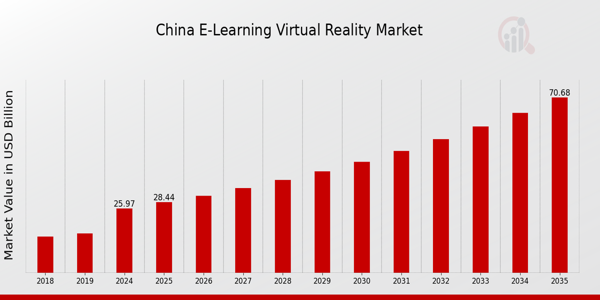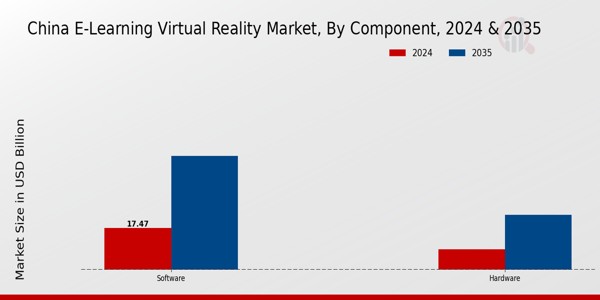China E-Learning Virtual Reality Market Overview
As per MRFR analysis, the China E-Learning Virtual Reality Market Size was estimated at 23.76 (USD Billion) in 2023.The China E-Learning Virtual Reality Market is expected to grow from 25.97(USD Billion) in 2024 to 70.69 (USD Billion) by 2035. The China E-Learning Virtual Reality Market CAGR (growth rate) is expected to be around 9.529% during the forecast period (2025 - 2035).
Key China E-Learning Virtual Reality Market Trends Highlighted
The China E-Learning Virtual Reality Market is experiencing significant growth driven by several key market drivers. One of the main factors is the rapid expansion of internet access and smartphone usage across urban and rural areas in China.
The Chinese government has been actively promoting digital education through various initiatives, including national policies aimed at enhancing the integration of technology in classrooms. In addition, the rising demand for interactive and immersive learning experiences is pushing educators and students to adopt virtual reality technologies to improve engagement and retention in learning processes.
Recent trends within the market showcase the integration of virtual reality in mainstream education, particularly in universities and vocational training.More and more schools are using VR to create real-life situations, which helps students improve their practical skills. In addition, the creation of new content that is specifically made for VR platforms is picking up speed, as are collaborations between tech companies and schools.
This opens up new ways to use VR technology in learning tools and apps. Gamification is also becoming more popular in e-learning, as developers add game-like features to the learning experience to make it more fun for users. This trend fits well with the younger generation's love of gaming, which makes virtual reality a great way to learn.
As the government continues to support the digital transformation of education in China, these emerging trends signal a robust potential for growth in the E-Learning Virtual Reality Market.

Source: Primary Research, Secondary Research, Market Research Future Database, and Analyst Review
China E-Learning Virtual Reality Market Drivers
Government Initiatives for Digital Education
The Chinese government has been actively promoting digital education to enhance learning outcomes in the nation. According to the Ministry of Education in China, initiatives such as the 'National Education Informatization 2.0 Action Plan' target the integration of information technology into education, emphasizing the role of innovative technologies like Virtual Reality (VR). With an allocation of substantial government funding exceeding $20 billion over the next five years for educational technology, the China E-Learning Virtual Reality Market is expected to experience significant growth.
This initiative aims to improve the educational quality and accessibility across urban and rural areas. Educational institutions, like Tsinghua University, are adopting VR in their curricula, gaining a competitive edge through enhanced learning experiences, which fosters a higher engagement and retention rate among students. The focus on technology-driven education is crucial for developing a skilled workforce that can thrive in a digital economy.
Rising Demand for Interactive Learning Solutions
As educational methodologies evolve, there is an increasing demand for interactive learning solutions in China. Recent studies indicate that immersive technologies like Virtual Reality improve student engagement by 35% compared to traditional teaching methods. This shift is supported by evidence from top educational institutions such as Peking University and Beijing Normal University, which show enhanced performance metrics when utilizing VR in classrooms.
The adoption of these interactive tools is correlated with research from the Ministry of Education, which highlights that students exposed to experiential learning environments score an average of 15% higher in assessments. The China E-Learning Virtual Reality Market is positioned to grow as educational stakeholders recognize the importance of engaging students through VR platforms.
Growing Adoption of Remote Learning Post-Pandemic
The COVID-19 pandemic has accelerated the adoption of remote learning across China, providing a significant boost to the China E-Learning Virtual Reality Market. According to data published by the National Bureau of Statistics of China, the number of online learners surged from 200 million in 2019 to over 300 million in 2021, underscoring the need for sophisticated e-learning solutions.
Educational platforms such as Tencent Classroom and Alibaba Cloud are incorporating Virtual Reality solutions to cater to the burgeoning demand for immersive online learning experiences.The long-term implications of these developments indicate a transition towards sustained digital learning environments, where VR can facilitate simulated hands-on experiences, making learning more effective and engaging for users across various educational levels.
China E-Learning Virtual Reality Market Segment Insights
E-Learning Virtual Reality Market Component Insights
The Component segment of the China E-Learning Virtual Reality Market is a crucial aspect, comprising various elements that facilitate immersive educational experiences. This segment is primarily divided into Hardware and Software, both of which play significant roles in enhancing learning methodologies across China. The Hardware aspect includes devices such as virtual reality headsets, motion sensors, and interactive displays, which are essential for delivering engaging and interactive E-learning experiences.
The rapid adoption of advanced technologies within educational institutions in China has led to an increasing demand for high-quality hardware solutions. On the other hand, the Software component encompasses applications that provide rich content tailored for virtual learning environments.
This includes learning management systems, interactive simulations, and educational games designed to improve user engagement and retention rates. The Software segment is vital for creating customized learning paths that can adapt to various student needs, thereby promoting more effective learning outcomes. In the context of China’s evolving educational landscape, both Hardware and Software components offer unique growth opportunities.
The government’s emphasis on digital learning and technological innovation has created a supportive environment that encourages the integration of such components into existing educational frameworks. Moreover, as virtual reality technology continues to mature, the potential for creating vivid and realistic learning scenarios becomes increasingly promising, resulting in an enriched learning experience for students.
Several factors contribute to the significance of the Component segment; for instance, the growing investment in educational technology by various stakeholders, including academies, corporations, and the government, enhances both hardware and software development. Additionally, advancements in artificial intelligence and data analytics are poised to complement these components, leading to more personalized and engaging educational experiences.
The ongoing exploration of virtual reality’s capabilities in promoting complex concepts and enhancing practical training makes this segment a central focus for education in China, underscoring its critical role in the overall evolution of E-learning methodologies within the region. Evaluating the trends, growth drivers, and challenges associated with the Component segment provides a comprehensive understanding of its impact on the future of education in China.

Source: Primary Research, Secondary Research, Market Research Future Database, and Analyst Review
E-Learning Virtual Reality Market Technology Insights
The China E-Learning Virtual Reality Market showcases significant advancements in technology, with diverse applications across various educational sectors. This segment particularly emphasizes two key types: Non-Immersive and Fully Immersive technologies. Non-Immersive technology has transformed traditional learning methods by incorporating multimedia elements into educational content, facilitating interactive learning experiences, and enhancing student engagement.
On the other hand, Fully Immersive technology creates realistic environments that enable learners to practice skills and scenarios in a safe setting, which is essential for vocational training and specialized education.In China, government initiatives and increasing investments in the education sector have driven the adoption of such technologies, addressing challenges related to distance learning and educational accessibility.
The growing penetration of high-speed internet and mobile devices has further propelled the demand for these technologies. These innovations not only cater to the evolving needs of learners but also align with the overall trend towards digital transformation in education, highlighting the significant role of the technology segment within the broader China E-Learning Virtual Reality Market.
E-Learning Virtual Reality Market Application Insights
The China E-Learning Virtual Reality Market showcases significant potential within the Application segment, underpinning its expansion in various educational environments. The Academic segment is vital as it caters to institutions aiming to enhance pedagogical methodologies, using immersive VR experiences to facilitate interactive learning.
This hands-on approach is particularly effective in higher education and professional training programs, enabling students to engage deeply with complex subjects. Conversely, the Corporate segment plays a crucial role in employee development, as companies increasingly leverage virtual reality for workforce training and skills enhancement.
This not only maximizes training efficiency but also minimizes logistical constraints associated with traditional learning methods. As China's emphasis on technology-driven education and ongoing investments in innovative training solutions continue, the Application segment is likely to experience a robust growth trajectory, driven by the increasing adoption of virtual reality technologies across academics and corporate settings.
China E-Learning Virtual Reality Market Key Players and Competitive Insights
The China E-Learning Virtual Reality Market is characterized by a rapidly evolving competitive landscape that reflects the increasing integration of advanced technologies in education. This market is driven by the demand for interactive and immersive learning experiences that cater to the shifting preferences of students and educational institutions. As educational content becomes increasingly digitized, the role of virtual reality as a medium for enhancing engagement and retention in learning is becoming crucial.
Various players in this market are focusing on innovative solutions that combine educational content with VR technology, creating personalized and effective learning experiences. The competition is not just among traditional education providers but also includes tech companies and startups specializing in virtual reality applications for learning purposes, which fosters a dynamic environment where new entrants can disrupt established norms.New Oriental Education & Technology Group stands out in the China E-Learning Virtual Reality Market due to its strong brand recognition and established presence in the education sector.
With a comprehensive portfolio that includes online education, test preparation, and professional training, the company effectively leverages its extensive resources to integrate virtual reality into its offerings.
New Oriental's strengths lie in its ability to develop high-quality educational content that appeals to a diverse audience, as well as its commitment to adapting to technological advancements. The company has made significant investments in research and development, enabling it to create immersive learning experiences that resonate well with students.
Furthermore, its longstanding relationships with various educational institutions position it favorably to expand its virtual reality initiatives and maintain a competitive edge in the evolving landscape.Learneo is another noteworthy player in the China E-Learning Virtual Reality Market, specializing in creating innovative, interactive educational solutions tailored to the needs of modern learners.
With a focus on technology-driven educational experiences, Learneo has developed several key products that utilize virtual reality to facilitate engaging learning environments. The company's presence in the market is underscored by its strategy to collaborate with schools and educational organizations, thereby enhancing the accessibility of its VR solutions. Learneo's strengths include its agile development approach, which allows it to quickly adapt to market needs and incorporate user feedback, as well as its dedication to fostering partnerships that enrich content offerings.
The company has also engaged in strategic mergers that bolster its technological capabilities and expand its footprint in the competitive market, further solidifying its position in the realm of e-learning.
Key Companies in the China E-Learning Virtual Reality Market Include
- New Oriental Education & Technology Group
- Learneo
- Tencent
- ByteDance
- ClassVR
- Knewton
- VR Education
- NetEase
- XIAOMI
- Baidu
- iQIYI
- Tal Education Group
- Dreamscape Immersive
- Alibaba
China E-Learning Virtual Reality Market Developments
In recent developments, the China E-Learning Virtual Reality market has witnessed significant advancements, particularly with key players like New Oriental Education and Technology Group, Tencent, and ByteDance enhancing their technology offerings. In September 2023, ByteDance launched a VR-based educational platform aimed at improving remote learning, reflecting the growing trend of integrating virtual reality within standardized education frameworks.
Additionally, in July 2023, New Oriental Education partnered with VR Education to enhance immersive learning experiences, showcasing a shift toward interactive teaching methods. Financially, multiple companies have seen growth; for instance, the overall market valuation for virtual reality in education has been projected to rise to $3 billion by the end of 2024, significantly impacting investment strategies and technology adoption.
Mergers and acquisitions have also played a role, with companies like Alibaba acquiring VR content startups in August 2023 to bolster their offerings in e-learning. In the last few years, regulatory support from the Chinese government has pushed for digital transformation in education, emphasizing the need for high-quality e-learning solutions, which arereshaping the market landscape.
China E-Learning Virtual Reality Market Segmentation Insights
-
E-Learning Virtual Reality Market Component Outlook
-
E-Learning Virtual Reality Market Technology Outlook
- Non-Immersive
- Fully Immersive
-
E-Learning Virtual Reality Market Application Outlook
| Report Attribute/Metric Source: |
Details |
| MARKET SIZE 2023 |
23.76(USD Billion) |
| MARKET SIZE 2024 |
25.97(USD Billion) |
| MARKET SIZE 2035 |
70.69(USD Billion) |
| COMPOUND ANNUAL GROWTH RATE (CAGR) |
9.529% (2025 - 2035) |
| REPORT COVERAGE |
Revenue Forecast, Competitive Landscape, Growth Factors, and Trends |
| BASE YEAR |
2024 |
| MARKET FORECAST PERIOD |
2025 - 2035 |
| HISTORICAL DATA |
2019 - 2024 |
| MARKET FORECAST UNITS |
USD Billion |
| KEY COMPANIES PROFILED |
New Oriental Education & Technology Group, Learneo, Tencent, ByteDance, ClassVR, Knewton, VR Education, NetEase, XIAOMI, Baidu, iQIYI, Tal Education Group, Dreamscape Immersive, Alibaba |
| SEGMENTS COVERED |
Component, Technology, Application |
| KEY MARKET OPPORTUNITIES |
Increased government education funding, Rising demand for remote learning, Growth in technical skill training, Enhanced engagement through gamification, Adoption in vocational education programs |
| KEY MARKET DYNAMICS |
growing demand for immersive learning, advancements in VR technology, increasing investments in edtech, government support for digital education, rise in remote learning solutions |
| COUNTRIES COVERED |
China |
Frequently Asked Questions (FAQ):
The China E-Learning Virtual Reality Market is projected to be valued at 25.97 USD Billion in 2024.
By 2035, the market is expected to reach a value of 70.69 USD Billion.
The expected CAGR for the market during this period is 9.529 percent.
Major players include New Oriental Education & Technology Group, Tencent, ByteDance, and Alibaba among others.
The hardware segment is valued at 8.5 USD Billion in 2024.
The software segment is anticipated to be valued at 17.47 USD Billion in 2024.
The hardware market is projected to grow to 23.0 USD Billion by 2035.
By 2035, the software component is expected to reach 47.69 USD Billion.
Key growth drivers include the increasing adoption of immersive learning technologies and demand for enhanced educational experiences.
The ongoing global economic trends are anticipated to have a significant impact on market dynamics and growth opportunities.
















